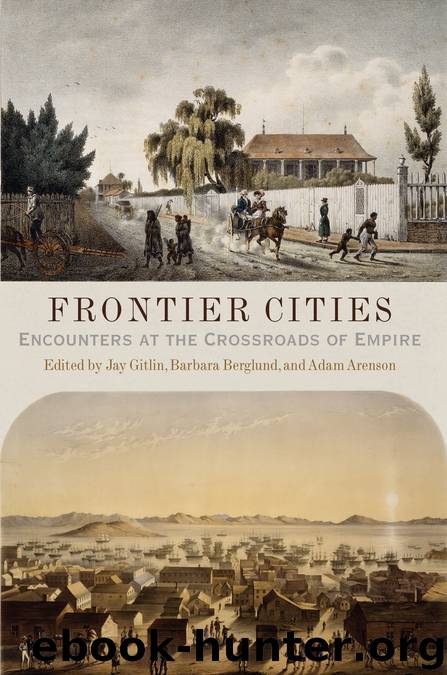Frontier Cities by Gitlin Jay; Berglund Barbara; Arenson Adam

Author:Gitlin, Jay; Berglund, Barbara; Arenson, Adam
Language: eng
Format: epub
Publisher: University of Pennsylvania Press, Inc.
CHAPTER 9
Mapping the Urban Frontier and Losing Frontier Cities
Peter J. Kastor
Estwick Evans worried about New Orleans. A New Hampshire native who engaged in a lengthy passage through the northern and western borderlands in 1818, Evans expressed those fears in a detailed narrative of his travels. When it came to New Orleans, the quintessential frontier city, Evans asked “will not our citizens . . . more readily imbibe, and more freely communicate the corrupt practices of this place? But, if by the praiseworthy conduct of our citizens residing in New-Orleans, immorality shall be checked, and good principles introduced, then, indeed, it will prove a purchase, not only for our country, but for mankind.”1
What do we make of this passage? At first glance, Evans’s worries seem to be the typical ranting of so many New Englanders who saw in the frontiers of North America the corruption that emerged when civilized Anglo-Americans came in contact with the decivilizing trifecta of Catholic religious culture, French and Spanish political culture, and multiracial contact culture. But remove “New Orleans” from the picture and this could well read like Thomas Jefferson’s tirade in Notes on the State of Virginia that “the mobs of great cities add just so much to the support of pure government, as sores do to the strength of the human body. It is the manners and spirit of a people which preserve a republic in vigour. A degeneracy in these is a canker which soon eats to the heart of its laws and constitution.”2
That similarity is more than coincidental and, in the end, not nearly so problematic as it may appear. It seems impossible to tease from Evans the threads of his commentary on frontiers from his commentary on cities. Yet the confluence of the two goes a long way toward explaining not only how Evans described New Orleans, but more generally how American print and visual culture went about constructing the cities of North America’s frontiers.
With that in mind, I would like to explore how frontier cities entered the American imagination through a series of travel narratives and maps published during the early American republic. To that end, this essay employs many of the same sources as the other participants in this volume, but for different purposes. Much of the best work in political, cultural, and social history has sought to extract the lived reality of North American frontiers from a set of deeply problematic texts. This work has sought to separate the wheat from the chaff, extracting a limited amount of believable information and discarding the large amount of extraneous or inaccurate material. I don’t envy the challenge of scholars who must disentangle a historical narrative about people who left few written records of their own from the cultural baggage that Europeans and Euro-Americans carried with them to the frontiers of North America. Indeed, my goal is to treat those problems as opportunities. I want to situate all the downsides of printed sources—the skewed perceptions, the misunderstood moments, the self-serving racial
Download
This site does not store any files on its server. We only index and link to content provided by other sites. Please contact the content providers to delete copyright contents if any and email us, we'll remove relevant links or contents immediately.
The Secret History by Donna Tartt(18166)
The Social Justice Warrior Handbook by Lisa De Pasquale(11954)
Thirteen Reasons Why by Jay Asher(8456)
This Is How You Lose Her by Junot Diaz(6440)
Weapons of Math Destruction by Cathy O'Neil(5833)
Zero to One by Peter Thiel(5494)
Beartown by Fredrik Backman(5362)
The Myth of the Strong Leader by Archie Brown(5239)
The Fire Next Time by James Baldwin(5017)
How Democracies Die by Steven Levitsky & Daniel Ziblatt(4959)
Promise Me, Dad by Joe Biden(4909)
Stone's Rules by Roger Stone(4863)
100 Deadly Skills by Clint Emerson(4692)
A Higher Loyalty: Truth, Lies, and Leadership by James Comey(4552)
Rise and Kill First by Ronen Bergman(4545)
Secrecy World by Jake Bernstein(4389)
The David Icke Guide to the Global Conspiracy (and how to end it) by David Icke(4382)
The Farm by Tom Rob Smith(4325)
The Doomsday Machine by Daniel Ellsberg(4247)
